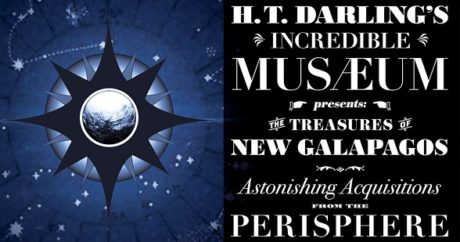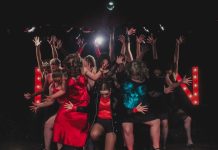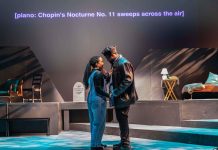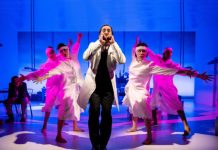In April of this year, I wrote:
Submersive Productions has outdone itself with its new production, H.T. Darling’s Incredible Musaeum presents: The Treasures of New Galapagos, Astonishing Acquisitions from the Perisphere. Drawing on myriad arts and disciplines – performance, movement, video, lights, objects, interactive sets, exceptional puppetry and an original soundtrack – it is a fully immersive experience that has something to dazzle all the senses. True to its mission to “activate unused, underused or unusual spaces in Baltimore,” Submersive has made the Peale Museum come alive with one of the most exciting theatrical experiences of the year.
Well, the year’s almost over now and it’s still true: Musaeum is a must-see. And because you’ve been very good, you’re getting one more chance to experience it. To prepare yourself for the awesomeness that is to come, read my review of the original production (spoiler-free and covers things like parking and accessibility) and check out this interview with the visionary founders of Submersive Productions, Glenn Ricci and Ursula Marcum.
Patricia: Could you each please introduce yourselves to readers who may not be familiar with you by name?
Glenn Ricci: Ursula and I are both Co-artistic Directors of Submersive Productions. During a given project we each wear a number of hats and serve on the project’s core creative team. For Musaeum, I am the Co-director (with Susan Stroupe and Lisi Stoessel) and sound designer and also created a number of projections and original photography for the show. Ursula is the puppet fabricator, puppeteer, prop master, and set dresser.
Likewise, what’s your “elevator pitch” description of Submersive Productions? Do you have one for H.T. Darling’s Incredible Musaeum Presents: The Treasures of New Galapagos, Astonishing Acquisitions from the Perisphere?
Glenn: We call Submersive “a collaborative artworks company that combines artistic disciplines to create memorable and profound audience experiences.” We are often called a theater company, and we do work with a lot of folks from the theater world, but ultimately our process is different from one you would use to put on a play. Hence the more convoluted description.
Ursula: For Musaeum: You are an invited guest of H.T. Darling for the grand opening of his latest exhibition of artifacts and creatures from the planet New Galapagos. You will choose your own path through the evening’s strange events.
What was your first introduction to immersive theater and experience-based art?
Glenn: I grew up working in haunted houses and always enjoyed the world-building aspects of it. You might say that haunted houses have provided a decades-old version of immersive theater, but of course their primary goal is to scare people. I’ve long thought that it would be fun to create a living environment and use it to tell stories that were full of nuance and detail. Around 2011-2012, a number of immersive shows appeared that seemed to spark a new interest in the form. Within a period of a few months, we went to Punchdrunk’s Sleep No More (NYC), Bricolage’s STRATA (Pittsburgh), Third Rail’s Then She Fell (Brooklyn), Yvonne Meier’s The Shining (Brooklyn) and a show called Her Things that my friend Ayne Terciera created with her group Uncumber in Pittsburgh. I was especially inspired by the shows with smaller audiences that managed to do a lot with just a few rooms.
In 2013, Ursula and I worked with The ScareHouse in Pittsburgh to create The Basement — a new type of horror-themed attraction that was focused on one or two audience members at a time. We learned a lot from that and decided it was time to make something of our own in Baltimore. Our first work, The Mesmeric Revelations! of Edgar Allan Poe, had over sixty showings in 2015 and built a dedicated little following. Some people went over a dozen times.
Ursula: My educational background is in theater and museum studies, both of which seek to have impact on audiences. As a visual artist, I was most interested in installation work where the audience physically participates in bringing their own meaning to the subject matter. While I was in grad school, I saw a museum exhibition created by Antenna, a company that specializes in audio experiences, that deeply affected me. The exhibition had audience members move through dream-like installations while listening to a soundscape that reflected on addiction and its effects on society. It was powerful and I never forgot it. When we started go to those immersive shows Glenn mentioned, I was reminded of that experience and was inspired to explore that style of audience engagement.
Do you know where the inspiration for H.T. Darling and New Galapagos was born? Was there a particular spark that set this creative fire ablaze?
Glenn: Our Co-director and Set Designer, Lisi Stoessel, was performing for us in Mesmeric Revelations when she told us she had been thinking about a show in which a museum comes to life. We told her that sounded right up our alley and that we’d like first dibs on producing it. She had already built some of the puppets and had some ideas about what would happen in the show. Early on in the production planning, we came up with the character of H.T. Darling, a sort of amalgum of the fictional Barron Munchausen and real life 18th-19th century explorers like Percy Fawcett. That provided a rich vein of research. Deciding that the objects in the exhibit would be from another planet added a layer of science fiction that was exciting to all of the artists involved. The sci-fi aspect also let us confront issues of race, gender, “the other”, and museum ethics in complex and engaging ways.
The characters and concepts all started with sketches and ideas from the core creative team. Once you start devising, the performers’ contributions tend to have powerful sway over the storylines, so this time we gave the artists a few months head start and introduced some of that work into the devising process. What you end up seeing in the show was fleshed out over many months of devising work with the performers fed back into the fabrication and set design process in a constant loop. We were lucky that so many people took this deep dive with us, and took the world so seriously, that we were able to generate an enormous amount of material. It is much more than any one person can take in during their two-hour visit.
How did you select the Peale? Having seen the original Musaeum there, it’s hard to imagine it taking place anywhere else. Did you have other location candidates in mind?
Ursula: We were kicking a few ideas around, but it was early in our search when Glenn, Lisi, and I went to an art installation at the Peale put on by The Contemporary. Within a few minutes we all felt like we just had to make it there. I already knew its history as the first purpose-built museum in the country, but it was simply perfect for the show. What we call the Grand Exhibition Hall was designed exactly for the kind of “cabinet of curiosity” style of exhibition that we wanted to re-create.
Please share one of the biggest surprises you had bringing Musaeum Mark I to life.
Glenn: It’s always fun and surprising to hear the audience’s interpretations of what they experienced. We spend months creating these elaborate narratives and backstories, but do not deliver them in any direct way. It’s definitely not all in the dialogue, and there is no single scene or piece of “evidence” in the set that will explain everything. Instead, we’re putting a great deal of trust in the audience to piece together their own narrative. A lot of people come up with interpretations that we have never thought of, and yet fit their experience perfectly. That is just endlessly fun.
Ursula: With so much focus on audience experience, you never know what you have until an audience actually shows up. We’ve learned enough to be able to plan for a lot of contingencies, but the audience will always surprise you. You always need to allow time for test with people who have no idea what to expect. And the audience’s personality can be vary different from night to night, so you need to do it more than once. All the characters follow a particular pathway every night and all major scenes are scripted, but the results can change drastically based on what the audience is doing. Just when you think you’ve planned for every contingency, they go and do something else.
What’s been surprising as you’ve been putting the redux together?
Glenn: Remounts are a great opportunity to take another pass at things and pick up any pieces you feel you left on the table from last time. Because it’s a medium that lets you get as detailed as you can possibly imagine, and because there is always more than one thing happening in the show at a time, you have to keep asking yourself: When are we finished? When is it enough? Have we gone too far? Have we gone totally insane thinking that anyone will notice all the little details we’ve poured into this? Judging by our dress rehearsals this week, I think we’re finally there. Of course, eventually the calendar has the final say about when you’re done because you have to open the thing, but we find that we’re always tweaking and trying new things even during the run.
What were some of the challenges you faced making Musaeum a reality the first time around?
Ursula: Filling the whole space was a monumental undertaking. Our initial conception was for it to be a small show for about a dozen people in maybe two or three rooms. But the “fishbowl effect” is very powerful. You have this ten thousand square foot building and before you know it the project grows to fill every corner of it.
How many people did it take to create a world? How much time?
Glenn: I think we’ve lost count! Over thirty artists have made contributions to the work.
Will visitors who experienced Musaeum Mark I note any differences in the version that opens this week?
Ursula: Absolutely! We have added two new puppeteers (for a total of four), several more puppets, a number of new scenes, and enhancements to a number of spaces. The third floor and the Grand Hall have both seen significant upgrades. We’ve added a few new one-to-one encounters as well.
Glenn: Our dress rehearsal audiences report that the whole thing feels fuller, more fleshed out. The space has a more lived-in feeling about it. You just accept it as if The Peale always looked this way, even though we brought in everything and have a reason behind every object placed in the space.
Before Musaeum, I was decidedly not a fan of puppets. Seeing them in the context of this production changed that. I can see why the Henson people wanted to support this work.
Glenn: A lot of people have told us that! Puppets are showing up in theater a lot lately with mixed success. This show in particular has a very solid reason for them to be there. I mean, how else were we going to show you creatures from another planet? We have just about every type of puppet imaginable and our fabricators have done a wonderful job making creatures that the audience can connect with. I do not know of another immersive theater piece that uses puppetry to such a large extent.
Ursula: As puppeteer, it’s a fun way to interact with the audience. Seeing adults become playful and sympathetic to this object on my hand is a truly magical experience.
This may be unanswerable, but do you ever take a step back and recognize the great impact that your work and your leadership has had on the Baltimore theater and arts community? Can you recognize the influence your dynamic duo-ness has had on the arts scene?
Glenn: Honestly, that’s a hard thing to wrap my brain around. What I can tell you is that we’re grateful for the warm reception we’ve had from the arts community here. Theater companies have taken note of how we’re bringing in a newer and somewhat younger audience who would not typically go to see a play. Likewise, I think this show has started a conversation with some folks in the museum industry. Then there’s the very dedicated group immersive theater fans from all over the country. They know how rare these sorts of productions are and will travel far to see them. Dozens of people who have never been to Baltimore have come to see our shows, so I think we’ve put the city on the map for them.
What’s next for Submersive?
Glenn: We are devising a solo piece with Michele Minnick, one of our Artistic Associates, that is slated to open in March. It’s called BATS! and will be a contemplation on the nature of fear and madness – with accordion songs. We would also like to do a second Plunge, which was our first production in 2017 that was made up entirely of one-to-one experiences.
Ursula: We would like to continue our work engaging with museums and thinking about them in new ways. Museums are unique spaces where we can reckon with our own history. In this country, and in Baltimore especially, we still have a lot of reckoning left to do.
H.T. Darling’s Incredible Musaeum presents: The Treasures of New Galapagos, Astonishing Acquisitions from the Perisphere plays through December 17, 2017, at Submersive Productions, playing at the Peale Museum – 225 North Holliday Street, in Baltimore, MD. For tickets, purchase them online.






